History
The first historical mention of a fare strike in the United States was in 1944 in Cleveland, Ohio when "streetcar workers threatened to refuse to collect fares in order to win a pay increase." The action was effective because "the City Council gave in before they actually used the tactic." [1] These kinds of "social strikes," collective acts of refusal where workers continue to provide services (in this case, transit) but do not collect any money, have occurred in France and parts of Latin America.
In 1969, Italy's "Hot Autumn" was sparked at FIAT's Mirafiori plant in Turin and spilled past the factory gates as workers coordinated movements using other forms of the social strike: FIAT workers refused to pay for the trams and buses and went into stores to demand reductions in prices, backed only by showing their factory ID badges. Others squatted houses and collectively refused to pay utility bills. [2] These kinds of struggles spread throughout Italy until the end of the 1970s.
Another type of social strike occurred during the 1970 postal strike in the United States when "letter carriers promised to deliver welfare checks even while on strike." [1] In 2004, much like in the 1944 example in Cleveland, the Chicago group Midwest Unrest was able to organize a fare strike that forced the Chicago Transit Authority to back down on service cuts and fare increases. In 2005, at least 5,000 riders participated in the first ever fare strike in Vancouver, British Columbia, Canada. [3]
In San Francisco, in 2005, "Despite heavy police presence at major bus transfer points, at least a couple thousand passengers rode the buses for free in San Francisco on Thursday, September 1st - the opening day of a fare strike in North America's most bus-intensive city." [4] Two of the main groups involved in organizing this were Muni Social Strike and Muni Fare Strike. Other community groups also participated, including the Chinese Progressive Association and "the one major extension of the strike, through the participation of the day laborers' organization in organizing among Spanish-speaking immigrants" [5] working class in San Francisco's Mission District, where the strike was most successful.
In Montreal, striking students in 2005 often used the subway as a means of transportation during demonstrations. As a group, the demonstration would enter the subway without paying, usually while chanting "Métro populaire." [6]
In New York City, Occupy Wall Street activists chained and taped open service gates and turnstiles to the subway system to protest "escalating service cuts, fare hikes, racist policing, assaults on transit workers' working conditions and livelihoods — and the profiteering of the super-rich by way of a system they've rigged in their favor" on March 28, 2012. [7]
In Grand Rapids, in 2016, a coalition of community activists boarded numerous city buses and refused to pay; part of a "Day of Action" against The Rapid, which culminated in a sit-in aimed at disrupting a scheduled board of directors meeting later that same day. The activists were protesting the board's refusal to negotiate a contract settlement with the workers of Amalgamated Transit Union Local 836, violations of those workers' First Amendment rights, a 16% fare hike, and a raise given to CEO, Peter Varga, while these perceived attacks on workers and riders were taking place. This was the first fare strike in Michigan history. [8] [9] [10]
In Okayama, Japan, a fare collection strike took place at Ryobi Bus in 2018. [11]

Bay Area Rapid Transit (BART) is a rapid transit system serving the San Francisco Bay Area in California. BART serves 50 stations along six routes and 131 miles of track, including eBART, a 9-mile (14 km) spur line running to Antioch, and Oakland Airport Connector, a 3-mile (4.8 km) automated guideway transit line serving San Francisco Bay Oakland International Airport. With an average of 169,800 weekday passenger trips as of the third quarter of 2024 and 48,119,400 annual passenger trips in 2023, BART is the sixth-busiest rapid transit system in the United States.

The San Francisco Municipal Railway ( MEW-nee; SF Muni or Muni), is the primary public transit system within San Francisco, California. It operates a system of bus routes, the Muni Metro light rail system, three historic cable car lines, and two historic streetcar lines. Previously an independent agency, the San Francisco Municipal Railway merged with two other agencies in 1999 to become the San Francisco Municipal Transportation Agency (SFMTA). In 2018, Muni served 46.7 square miles (121 km2) with an operating budget of about $1.2 billion. Muni is the seventh-highest-ridership transit system in the United States, with 142,168,200 rides in 2023, and the second-highest in California after the Los Angeles County Metropolitan Transportation Authority.

The New York City Transit Authority is a public-benefit corporation in the U.S. state of New York that operates public transportation in New York City. Part of the Metropolitan Transportation Authority, the busiest and largest transit system in North America, the NYCTA has a daily ridership of 8 million trips.
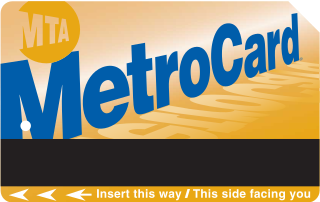
The MetroCard is a magnetic stripe card used for fare payment on transportation in the New York City area. It is a payment method for the New York City Subway, New York City Transit buses and MTA buses. The MetroCard is also accepted by several partner agencies: Nassau Inter-County Express (NICE), the PATH train system, the Roosevelt Island Tramway, AirTrain JFK, and Westchester County's Bee-Line Bus System.
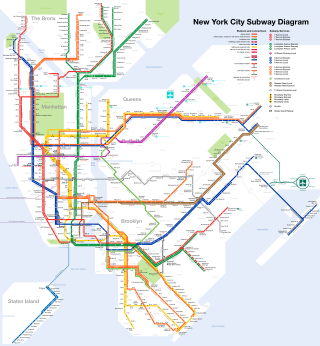
The New York City Subway is a rapid transit system that serves four of the five boroughs of New York City, New York: the Bronx, Brooklyn, Manhattan, and Queens. Its operator is the New York City Transit Authority, which is itself controlled by the Metropolitan Transportation Authority of New York. In 2015, an average of 5.65 million passengers used the system daily, making it the busiest rapid transit system in the United States and the 11th busiest in the world.

York Region Transit (YRT) is the public transit operator in York Region, Ontario, Canada. Its headquarters are in Richmond Hill, at 50 High Tech Road.

Muni Metro is a semi-metro system serving San Francisco, California, United States. Operated by the San Francisco Municipal Railway (Muni), a part of the San Francisco Municipal Transportation Agency (SFMTA), Muni's light rail lines saw an average of 87,000 boardings per day as of the third quarter of 2024 and a total of 24,324,600 boardings in 2023, making it the sixth-busiest light rail system in the United States.

Powell Street station is a combined BART and Muni Metro rapid transit station in the Market Street subway in downtown San Francisco. Located under Market Street between 4th Street and 5th Street, it serves the Financial District neighborhood and surrounding areas. The three-level station has a large fare mezzanine level, with separate platform levels for Muni Metro and BART below. The station is served by the BART Red, Yellow, Green, and Blue lines, and the Muni Metro J Church, K Ingleside, L Taraval, M Ocean View, N Judah, and S Shuttle lines.

Civic Center/UN Plaza station is a combined BART and Muni Metro rapid transit station in the Market Street subway in downtown San Francisco. Located under Market Street between 7th Street and 8th Street, it is named for the Civic Center neighborhood and the adjacent United Nations Plaza. The three-level station has a large fare mezzanine level, with separate platform levels for Muni Metro and BART below.

The Central Subway is a Muni Metro light rail tunnel in San Francisco, California, United States. It runs between Chinatown station in Chinatown and a portal in South of Market (SoMa), with intermediate stops at Union Square/Market Street station in Union Square and Yerba Buena/Moscone station in SoMa. A surface portion runs through SoMa to connect to the previously existing T Third Street line at 4th and King station.
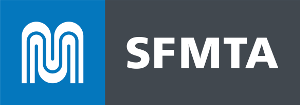
The San Francisco Municipal Transportation Agency is an agency created by consolidation of the San Francisco Municipal Railway (Muni), the Department of Parking and Traffic (DPT), and the Taxicab Commission. The agency oversees public transport, taxis, bicycle infrastructure, pedestrian infrastructure, and paratransit for the City and County of San Francisco.

Transport Workers Union of America (TWU) is a United States labor union that was founded in 1934 by subway workers in New York City, then expanded to represent transit employees in other cities, primarily in the eastern U.S. This article discusses the parent union and its largest local, Local 100, which represents the transport workers of New York City. TWU is a member of the AFL–CIO.
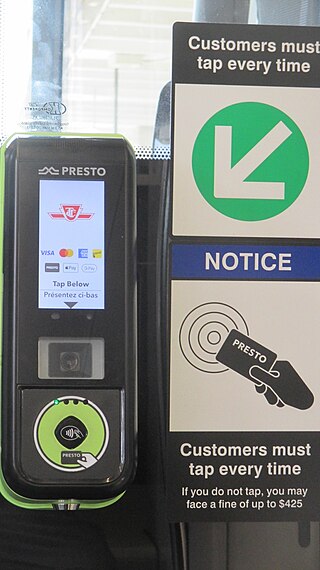
Fares to use the Toronto Transit Commission (TTC) transit system in Toronto, Ontario, Canada, can be paid with various media. The price of fares varies according to age, occupation, income level, and health condition of riders.
A 1980 transit strike in New York City halted service on the New York City Transit Authority for the first time since 1966. Around 33,000 members of Transport Workers Union (TWU) Local 100 walked off their jobs on April 1, 1980, in a strike with the goal of increasing the wage for contracted workers. All subway and bus lines in the five boroughs of New York City were brought to a complete standstill for twelve days. The strike was resolved on April 11.

The 2005 New York City transit strike, held from December 20 through 22, 2005, was the third strike ever by the Transport Workers Union Local 100 against New York City's Transit Authority and involved between 32,000 and 34,000 strikers.

The fares for services operated under the brands of MTA Regional Bus, New York City Subway, Staten Island Railway (SIR), PATH, Roosevelt Island Tramway, AirTrain JFK, NYC Ferry, and the suburban bus operators Nassau Inter-County Express (NICE) and Westchester County Bee-Line System (Bee-Line) are listed below. As of 2024, most bus routes, the subway, the Staten Island Railway, and the Roosevelt Island Tramway charge a $2.90 fare; a higher fare is charged for ferries, express buses, and the AirTrain JFK.
The Free Fare Movement is a Brazilian social movement that advocates the adoption of free fares in mass transit. The movement was founded in a session during the Worldwide Social Forum in 2005, in Porto Alegre, and gained prominence for its participation in the planning of the 2013 Brazilian protests.
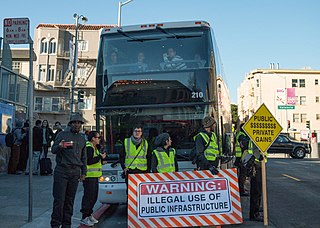
The San Francisco tech bus protests, also known as the Google bus protests, were a series of protests in the San Francisco Bay Area beginning in late 2013, when the use of shuttle buses employed by local area tech companies became widely publicized. The tech buses have been called "Google buses" although other companies—such as tech companies Apple, Facebook, and Yahoo, and biotechnology corporation Genentech—also pay for private shuttle services.
OMNY is a contactless fare payment system, currently being implemented for use on public transit in the New York metropolitan area. OMNY can currently be used to pay fares at all New York City Subway and Staten Island Railway stations, on all MTA buses, AirTrain JFK, Metro North's Hudson Rail Link, and on the Roosevelt Island Tram; when completely rolled out, it will also replace the MetroCard on Bee-Line buses, and NICE buses. OMNY will also expand beyond the current scope of the MetroCard to include the Long Island Rail Road and Metro-North Railroad.
The Pos Me Salto Movement was a protest campaign that took place in the Mexico City metro system in response to a 40% fare increase on 13 December 2013, which abruptly made the transit system one of the world's most expensive. It was launched on Twitter by means of the #PosMeSalto hashtag.















